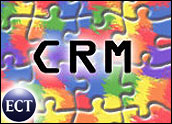
Throughout the last few months of 2005 there was a pronounced ramp-up in activity around Web Services to enable integration of marketing, sales and CRM databases so that more precise selling strategies could be created.
The holy grail of CRM — achieving a single view of the customer — is within reach for companies starting to experiment with Web Services. Many of these companies are building applications and pursuing strategies completely on their own, looking for Web Services to be the glue that binds legacy, home-grown and ERP platforms.
There’s a ton of experimentation going on with Web Services, specifically with IT staffs dabbling in development. They are starting to demonstrate that object-oriented programming tools can deliver now. One company has been able to synchronize multiple order-capture systems using Web Services they created on their own, for example. The payoffs for this work are more order accuracy and efficiency.
What’s Really Happening in Web Services Today
Forget about the commercials and hype showing Web Services as an all-knowing and all-seeing platform that can tell any salesperson at anytime, from anywhere, the status of orders in a remote location. It could happen — but in the world of Web Services today, only those companies that are on a single platform worldwide can consistently deliver that level of responsiveness and visibility on a 24/7 basis.
In an age of mergers, acquisitions, spinoffs and legacy-system turf battles, a single global platform is more the exception than the rule, and hand-built adapters and integrations are commonplace. Sending a query from an airport lounge in London to a server in Burlingame, Calif., for example, is a tenuous operation within the typical IT infrastructure.
The reality is that there are many more “crawl, walk, run” adoption-and-testing scenarios than there are global deployments. Based on the research I completed for this article — and according to multiple companies I’ve spoken with — there is more of a focus on test driving Web Services today than on en masse development.
Several companies I contacted are concerned more with security than time and cost savings. Despite the hype surrounding Web Services as the Next Big Thing, it’s clear from watching companies that have adopted this approach to database integration management that it takes, on average, 15 months to make Web Services fully operational. This is often the case in the financial services sector, for example, specifically when an organization includes three or more Web Services in the system.
For the companies using Web Services, ROI is proving elusive to quantify — much less track over time. Because most of them do not conduct an ROI analysis before starting, they often have high expectations that are not met and, as a result, resort to rationalizations about how Web Services contribute to cost reductions or revenue growth. A lack of clarity regarding the influence of Web Services on business goals and objectives is an impediment to the technology’s growth in CRM today.
SOA by Any Other Name
A grouping of Web Services actually creates a Service Oriented Architecture (SOA), according to some CRM vendors. Although the notion of an SOA is often met with even more skepticism, it’s becoming clear that the Web services concept is starting to pay off as a database integration strategy.
That will make the positioning of a one-size-fits-all SOA platform a tough sell that will only get tougher as successful Web Services projects deliver integration results. With integration in hand, why move en masse to an entirely new platform? That’s the question many CIOs are asking themselves, given the onslaught of SOA options in the market and the speed that Web Services adoption is enjoying in some quarters.
Summary
It’s a good idea to get a snapshot of what’s happening with Web Services in CRM from time to time, just to check up on how companies are progressing in their quest to deliver a single view of the customer. Web Services technology is increasingly becoming the basis of an integration strategy for unifying databases to deliver much-needed customer sales and purchasing histories.
In the case of a mortgage lender, Web Services development accounts for the majority of the IT staff’s programming workload. One vice president of infrastructure told me he would rather spend on Web Services to deliver integration than tie up internal IT staff with adapter and connector fixes.
The collective reasoning is that Web Services can fix integration problems, while at the same time requiring IT staffs to gain new skills.
All of this ties back to CRM through CIO priority lists, many of which include integration projects as deliverables in the first half of this year.
Louis Columbus, a CRM Buyer columnist, is a former senior analyst with AMR Research. He is the author of several books on making the most of analyst relationships, including Best Practices in Analyst Relations, which can be downloaded for free.













































